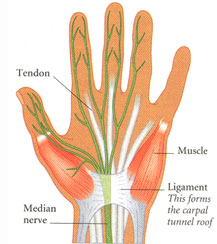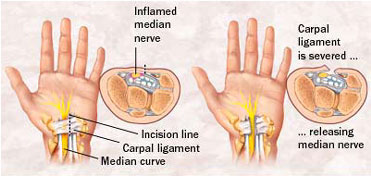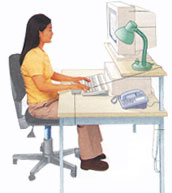|
|
Carpal Tunnel Syndrome (CTS) : A Repetitive Motion Disorder
 Carpal tunnel syndrome is a condition in which pressure on a nerve that leads
from your spinal cord to your hands causes numbness pain or tingling in your
hands or fingers. The carpal tunnel is a narrow passage formed by
ligaments in your wrist through which nerves and tendons pass. When the muscles
and ligaments of the carpal tunnel become swollen or inflamed, they compress the
median nerve which leads to your thumb and first two fingers. This pressure
causes pain or numbness. In some cases both wrists are affected. Carpal tunnel syndrome is a condition in which pressure on a nerve that leads
from your spinal cord to your hands causes numbness pain or tingling in your
hands or fingers. The carpal tunnel is a narrow passage formed by
ligaments in your wrist through which nerves and tendons pass. When the muscles
and ligaments of the carpal tunnel become swollen or inflamed, they compress the
median nerve which leads to your thumb and first two fingers. This pressure
causes pain or numbness. In some cases both wrists are affected.
|
Who are at risk?
Recent studies have shown that
carpal tunnel syndrome, like all other cumulative trauma disorders, is on the
rise while other workplace injuries have leveled off. Some people seem to be
genetically inclined to CTS. Carpal tunnel syndrome is more common in women than
men, and is often found in workers whose tasks require repeating the same motion
in the fingers and hand for long periods of time.
CTS has surfaced among
meatpackers, assembly line workers, jackhammer operators, and employees who
spend hours working at a computer or typewriter. Carpal tunnel syndrome shows up
in athletes as well as homemakers.
The U.S. Department of Labor has
cited carpal tunnel syndrome, as well as other cumulative trauma disorders, as
the cause of 48 percent of all industrial workplace illnesses. The disease
affects more than five million Americans.
SYMPTOMS
Typical
times when you might experience symptoms due to carpal tunnel syndrome include
while holding a phone or a newspaper, gripping a steering wheel, or sleeping.
The symptoms of carpal tunnel syndrome may come and go, and include the
following:-
-
Numbness in your hands or
fingers (especially the thumb and first two finger)
-
Pain that starts in your wrist
and shoots down into the palm of your hands or the surface of your fingers, or
up into your forearms,
-
Pain or numbness that increase
at night particularly after a day during which you have used your hands more
than usual in a repetitive activity, and
-
Pain or numbness in your hands
during pregnancy or shortly after.
-
Trouble gripping objects.
-
Weakness in your thumb
The symptoms are often
progressive. At first you may be bothered only at night partly because fluids
are more likely to accumulate in your arms and legs while your sleep. The
symptoms may begin to occur at other times. Gradually, even simple tasks become
painful. In some cases the disorders goes away on its own. In others cases if
the conditions is not treated, it can progress until you can not use the
affected hands.
CAUSES
The cause
of carpal tunnel syndrome is pressure put on the median nerve. The median nerve
is a mixed nerve, meaning it has a sensory function and also provides nerve
signals to move your muscles (motor function). The median nerve provides
sensation to your thumb, index finger, middle finger and the middle finger side
of the ring finger. Pressure on the nerve can stem from anything that reduces
the space for it in the carpal tunnel. Causes might include anything from bone
spurs to the most common cause, which is swelling or thickening of the lining
and lubricating layer (synovium) of the tendons in your carpal tunnel.
-
The disorders usually occurs due
to repetitive stress on one or both wrists - such as word processing
operators, computer operators, chefs, factory workers, librarians and
violinists.
-
Hobbies such as gardening,
needlework, golfing and canoeing can sometimes bring on the symptoms.
-
The condition can occur in
pregnant women and in women who have recently given birth, because the buildup
of fluid in their body during pregnancy puts extra pressure or nerves.
-
In some cases carpal tunnel
syndrome is caused by a disease such as
diabetes, rheumatoid
arthritis,
or hypothyroidism that affects the blood vessels of the median nerve or
the connective tissue (the carpal tunnel or ligaments) in the wrist.
-
It may be caused by an injury to
the wrist, such as a fracture.
Sleeping with your wrist bent
sharply inward can worsen the condition.
|
|
|
TREATMENT OPTIONS
If you are diagnosed with carpal
tunnels syndrome, your doctors may first recommend
-
Slowing down the pace at
which you work or resting the joint by avoiding the repetitive activity
with your wrist that caused the problem. You will be given advice about how to
modify your work area to put less strain on your wrists.
-
Your doctors may recommend
taking time off from work altogether to allow the inflammation to subside.
-
Using a splint at night
to keep your wrist straight can help relieve pain and other symptoms and allow
your you to get a good night's sleep. Your doctors may recommend that your
also wear the splint during the day to immobilize your wrist
 while
still allowing your hands to functions. while
still allowing your hands to functions.
-
If pain is a problems ask your
doctors about over the counter anti inflammatory medications (such as
pirin or ibuprofen or, if you are pregnant, acetaminophen). If you are
pregnant your symptoms will probably subside gradually after the pregnancy.
-
If your pain persists your
doctors may prescribe injections of a corticosteriod (synthetic
hormone) such as cortisone into your wrist to reduce pain and inflammation. If
the problem does not clear up after two injections of corticosteriods, you may
want to consider surgery.
-
The surgery for treating
carpal tunnels syndrome, called
carpal tunnel release
is a relatively fast and simple procedure that is performed to relive the
pressure on the median nerve. The surgery is done using local anesthesia
and usually does not require an overnight stay in the hospital. In this
procedure, the surgeons cuts the ligaments that form the carpal tunnel,
freezing the compressed median nerve. After 2 or 3 weeks, you can begin to use
your hand again. You may not gain complete functions for about 3 months
because the nerves must re-grow past the wrist into the muscles of the
hand and fingers. At times, surgery can be done
using an endoscope, a telescope-like device with a tiny television camera
attached to it that allows your doctor to see inside your carpal tunnel and
perform the surgery through small incisions in your hand or wrist.
a relatively fast and simple procedure that is performed to relive the
pressure on the median nerve. The surgery is done using local anesthesia
and usually does not require an overnight stay in the hospital. In this
procedure, the surgeons cuts the ligaments that form the carpal tunnel,
freezing the compressed median nerve. After 2 or 3 weeks, you can begin to use
your hand again. You may not gain complete functions for about 3 months
because the nerves must re-grow past the wrist into the muscles of the
hand and fingers. At times, surgery can be done
using an endoscope, a telescope-like device with a tiny television camera
attached to it that allows your doctor to see inside your carpal tunnel and
perform the surgery through small incisions in your hand or wrist.
-
If
carpal tunnel syndrome results from an inflammatory arthritis, such as
rheumatoid arthritis, then treating the underlying condition generally also
reduces the carpal tunnel syndrome symptoms. This may not be the case with all
underlying conditions, such as thyroid conditions or diabetes.
PREVENTING CARPAL TUNNEL SYNDROME:
-
-
Get treatment for any disease you have that may cause carpal tunnel
syndrome.
-
Switch hands during work tasks.
-
Don't rest your wrists on hard surfaces for long periods.
-
Don't sit or stand in the same position all day.
-
-
Making periodic minor adjustments in the positions of your hands or
wrists while you perform a repetitive activity can make a difference and
help you avoid carpal tunnel syndrome. If your work at a keyboard, type
with your wrists straight bent neither up nor down. To make this
adjustment, you
may have to raise or lower your seat.
Stop your work periodically to rest
your hands, by doing the following:-

-
Make a loose fist and open and gently stretch your hands. Repeat
several times.

-
Stand up and place your hands palms down on a table. Press firmly with
both of your hands against the table. Hold for 5 seconds and release.
Repeat four times.

-
Stand with your feet
slightly apart, knee straight and hands flat on a table. With elbows
slightly bent, lean forward with your weight on your wrists so that they
bend back slightly.
CHECK YOUR WRISTS POSITION AT THE KEYBOARD
 Many keyboard typists and computer users are affected by carpal tunnels
syndrome. Position your keyboard at a height where your wrist do not bend
up or down while your type. Your elbows should be at a 90 degree angle, with
your forearms parallel to the floor. To achieve the correct position, try
lowering your keyboard or raising your chair. Many keyboard typists and computer users are affected by carpal tunnels
syndrome. Position your keyboard at a height where your wrist do not bend
up or down while your type. Your elbows should be at a 90 degree angle, with
your forearms parallel to the floor. To achieve the correct position, try
lowering your keyboard or raising your chair.
NOTE:
If you or anyone you know has
symptoms of carpal tunnel syndrome, consult a physical therapist or other
qualified health care practitioner for an evaluation and individualized
treatment.
For more on Carpal Tunnel Syndrome:
|
|
|
|
|
|









